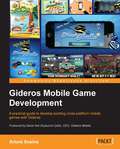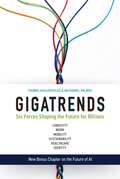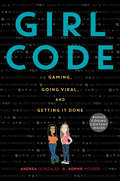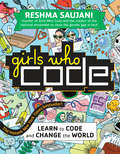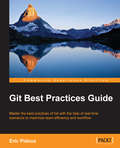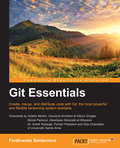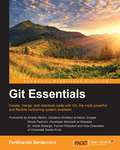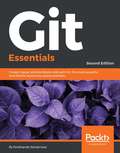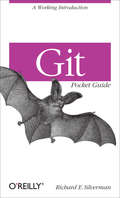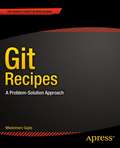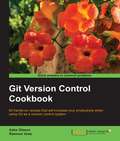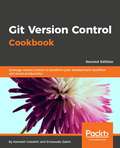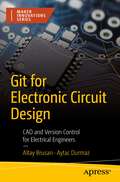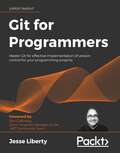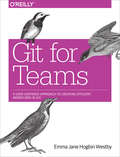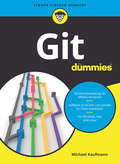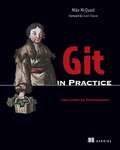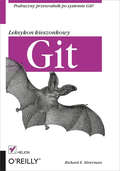- Table View
- List View
Gideros Mobile Game Development
by Arturs SosinsThis book is a detailed guide to create and deploy mobile games on multiple mobile platforms with an emphasis on practical examples that help you learn how to make your own games quickly and efficiently. This book is for developers who are new to mobile game development or who have tried the native development of mobile games and want a simpler, faster tool that can support a wide variety of platforms and devices. Readers are expected to be at least partially familiar with the Lua game scripting language that Gideros uses for its scripts.
Gigatrends: Six Forces That Are Changing the Future for Billions
by Thomas Koulopoulos Nathaniel PalmerGigatrends offers a roadmap for navigating six of the most disruptive trends shaping the future.Humanity stands at the precipice of a remarkable new era in global history filled with both immense opportunities and daunting challenges. Gigatrends examines how six disruptive trends can be harnessed to create new social, economic, and organizational solutions that will usher in the promise of a human-centered future for billions of people. But moving forward won&’t be easy. Gigatrends will disrupt nearly every existing socioeconomic system built over the past three hundred years. Navigating these seismic shifts will require a new set of skills, frameworks, and tools to help us move forward. Gigatrends will provide you with the insights to: • Understand how each of the six Gigatrends will shape your future • Predict how digital workers and AI will reshape the workforce • Create new social, economic, and organizational global ecosystems • Navigate the seismic shifts of a rapidly changing and uncertain world • Achieve a human-centered future that works for all of humanity • Recognize how digital identity will create a new era of prosperity The world is at an inflection point. It's time to understand and embrace the revolutionary power of Gigatrends to shape a future that&’s filled with hope and opportunity for all of humanity.
Girl Code: Gaming, Going Viral, and Getting It Done
by Andrea Gonzales Sophie HouserA New York Public Library Best Book of 2017Perfect for aspiring coders everywhere, Girl Code is the story of two teenage tech phenoms who met at Girls Who Code summer camp, teamed up to create a viral video game, and ended up becoming world famous. The book also includes bonus content to help you start coding! Fans of funny and inspiring books like Maya Van Wagenen’s Popular and Caroline Paul’s Gutsy Girl will love hearing about Andrea “Andy” Gonzales and Sophie Houser’s journey from average teens to powerhouses.Through the success of their video game, Andy and Sophie got unprecedented access to some of the biggest start-ups and tech companies, and now they’re sharing what they’ve seen. Their video game and their commitment to inspiring young women have been covered by the Huffington Post, Buzzfeed, CNN, Teen Vogue, Jezebel, the Today show, and many more.Get ready for an inside look at the tech industry, the true power of coding, and some of the amazing women who are shaping the world. Andy and Sophie reveal not only what they’ve learned about opportunities in science and technology but also the true value of discovering your own voice and creativity.A Junior Library Guild selectionA Children's Book Council Best STEM Trade Book for Students K-12
Girl Decoded: A Scientist's Quest to Reclaim Our Humanity by Bringing Emotional Intelligence to Technology
by Carol Colman Rana El KalioubyIn a captivating memoir, an Egyptian American visionary and scientist provides an intimate view of her personal transformation as she follows her calling—to humanize our technology and how we connect with one another. <P><P> Rana el Kaliouby is a rarity in both the tech world and her native Middle East: a Muslim woman in charge in a field that is still overwhelmingly white and male. Growing up in Egypt and Kuwait, el Kaliouby was raised by a strict father who valued tradition—yet also had high expectations for his daughters—and a mother who was one of the first female computer programmers in the Middle East. Even before el Kaliouby broke ground as a scientist, she broke the rules of what it meant to be an obedient daughter and, later, an obedient wife to pursue her own daring dream. After earning her PhD at Cambridge, el Kaliouby, now the divorced mother of two, moved to America to pursue her mission to humanize technology before it dehumanizes us. The majority of our communication is conveyed through nonverbal cues: facial expressions, tone of voice, body language. But that communication is lost when we interact with others through our smartphones and devices. <P><P> The result is an emotion-blind digital universe that impairs the very intelligence and capabilities—including empathy—that distinguish human beings from our machines. To combat our fundamental loss of emotional intelligence online, she cofounded Affectiva, the pioneer in the new field of Emotion AI, allowing our technology to understand humans the way we understand one another. Girl Decoded chronicles el Kaliouby’s journey from being a “nice Egyptian girl” to becoming a woman, carving her own path as she revolutionizes technology. But decoding herself—learning to express and act on her own emotions—would prove to be the biggest challenge of all.
Girl Forgotten
by April HenryPiper Gray starts a true-crime podcast investigating a seventeen-year-old cold case in this thrilling YA murder mystery by New York Times bestselling author April Henry. Seventeen years ago, Layla Trello was murdered and her killer was never found. Enter true-crime fan Piper Gray who is determined to reopen Layla&’s case and get some answers. With the help of Jonas—who has a secret of his own—Piper starts a podcast investigating Layla&’s murder. But as she digs deeper into the mysteries of the past, Piper begins receiving anonymous threats telling her to back off the investigation, or else. The killer is still out there, and Piper must uncover their identity before they silence her forever.
Girl Gone Viral
by Arvin AhmadiPerfect for fans of Warcross and Black Mirror, Girl Gone Viral is the inventive and timely story of a seventeen-year-old coder's catapult to stardom.For seventeen-year-old Opal Hopper, code is magic. She builds entire worlds from scratch: Mars craters, shimmering lakes, any virtual experience her heart desires. But she can't code her dad back into her life. When he disappeared after her tenth birthday, leaving only a cryptic note, Opal tried desperately to find him. And when he never turned up, she enrolled at a boarding school for technical prodigies and tried to forget.Until now. Because WAVE, the world's biggest virtual reality platform, has announced a contest where the winner gets to meet its billionaire founder. The same billionaire who worked closely with Opal's dad. The one she always believed might know where he went. The one who maybe even murdered him.What begins as a small data hack to win the contest spirals out of control when Opal goes viral, digging her deeper into a hole of lies, hacks, and manipulation. How far will Opal go for the answers--or is it the attention--she's wanted for years?
Girl Wide Web 2. 0: Revisiting Girls, The Internet, And The Negotiation Of Identity
by Sharon R. MazzarellaFrom social networking sites to game design, from blogs to game play, and from fan fiction to commercial web sites, Girl Wide Web 2.0 offers a complex portrait of millennial girls online. Grounded in an understanding of the ongoing evolution in computer and internet technology and in the ways in which girls themselves use that technology, the book privileges studies of girls as active producers of computer/internet content, and incorporates an international/intercultural perspective so as to extend our understanding of girls, the Internet, and the negotiation of identity.
Girlhood, Schools, and Media: Popular Discourses of the Achieving Girl (Routledge Research in Cultural and Media Studies)
by Michele PauleThis book explores the circulation and reception of popular discourses of achieving girlhood, and the ways in which girls themselves participate in such circulation. It examines the figure of the achieving girl within wider discourses of neoliberal self-management and post-feminist possibility, considering the tensions involved in being both successful and successfully feminine and the strategies and negotiations girls undertake to manage these tensions.The work is grounded in an understanding of media, educational, and peer contexts for the production of the successful girl. It traces narratives across school, television and online in texts produced for and by girls, drawing on interviews with girls in schools, online forum participation (within the purpose-built site www.smartgirls.tv), and girls’ discussions of a range of teen dramas.
Girls Just Want to Have Likes: How to Raise Confident Girls in the Face of Social Media Madness
by Laurie WolkAn educator and leadership coach teaches parents how to cut through daughters&’ addiction to social media and reclaim family connection. In today&’s age of social media, young girls are learning crucial life lessons from dubious mentors like the Kardashians and other Instagram &“celebrities.&” Many are so thoroughly addicted to social media they are uncomfortable communicating face to face. It&’s no wonder parents across the country are afraid for their daughters&’ self-esteem and ability to thrive in the real world. In Girls Just Want to Have Likes, educator and leadership coach Laurie Wolk offers smart advice on how parents can take control, communicate meaningfully with their children, and get back to raising confident capable young women. Laurie shows parents how to reclaim their roles as mentor and guide, helping their daughters unwind and decode the toxic messages social media broadcasts. By applying Laurie&’s methods, social media will start to fade into the background of your household, allowing family connection to take center stage—and letting your daughter shine.
Girls Who Code: Learn to Code and Change the World (Girls Who Code #1)
by Reshma Saujani<P>Part how-to, part girl-empowerment, and all fun, from the leader of the movement championed by Sheryl Sandberg, Malala Yousafzai, and John Legend. <P>Since 2012, the organization Girls Who Code has taught computing skills to and inspired over 40,000 girls across America. Now its founder, Reshma Saujani, wants to inspire you to be a girl who codes! <P>Bursting with dynamic artwork, down-to-earth explanations of coding principles, and real-life stories of girls and women working at places like Pixar and NASA, this graphically animated book shows what a huge role computer science plays in our lives and how much fun it can be. <P>No matter your interest—sports, the arts, baking, student government, social justice—coding can help you do what you love and make your dreams come true. Whether you’re a girl who’s never coded before, a girl who codes, or a parent raising one, this entertaining book, printed in bold two-color and featuring art on every page, will have you itching to create your own apps, games, and robots to make the world a better place. <P><b>A New York Times Bestseller</b>
Girls' Feminist Blogging in a Postfeminist Age (Routledge Studies in New Media and Cyberculture)
by Jessalynn KellerGirls’ Feminist Blogging in a Postfeminist Age explores the practices of U.S.-based teenage girls who actively maintain feminist blogs and participate in the feminist blogosphere as readers, writers, and commenters on platforms including Blogspot, Facebook, Twitter, and Tumblr. Drawing on interviews with bloggers between the ages of fifteen and twenty-one, as well as discursive textual analyses of feminist blogs and social networking postings authored by teenage girls, Keller addresses how these girls use blogging as a practice to articulate contemporary feminisms and craft their own identities as feminists and activists. In this sense, feminist girl bloggers defy hegemonic postfeminist and neoliberal girlhood subjectivities, a finding that Keller uses to complicate both academic and popular assertions that suggest teenage girls are uninterested in feminism. Instead, Keller maintains that these young bloggers employ digital media production to educate their peers about feminism, connect with like-minded activists, write feminist history, and make feminism visible within popular culture, practices that build upon and continue a lengthy tradition of American feminism into the twenty-first century. Girls’ Feminist Bloggers in a Postfeminist Age challenges readers to not only reconsider teenage girls’ online practices as politically and culturally significant, but to better understand their crucial role in a thriving contemporary feminism.
Git Best Practices Guide
by Eric PidouxIf you are a developer and you want to completely master Git without heavy theory, this is the book for you. A reasonable knowledge level and basic understanding of Git concepts will get you started with this book.
Git Essentials
by Ferdinando SantacroceIf you are a software developer with little or no experience of versioning systems, or are familiar with other centralized versioning systems, then this book is for you. If you have some experience working with command lines or using Linux admin or just using Unix and want to know more about Git, then this book is ideal for you.
Git Essentials
by Ferdinando Santacroce<P><P>Create, merge, and distribute code with Git, the most powerful and flexible versioning system available <P><P>About This Book <P><P>Master all the basic concepts of Git to protect your code and make it easier to evolve <P><P>Use Git proficiently, and learn how to resolve day-by-day tasks easily <P><P>A step-by-step guide, packed with examples to help you learn and work with Git internals <P><P>Who This Book Is For <P><P>If you are a software developer with little or no experience of versioning systems, or are familiar with other centralized versioning systems, then this book is for you. If you have some experience working with command lines or using Linux admin or just using Unix and want to know more about Git, then this book is ideal for you. <P><P>What You Will Learn <P><P>Create, branch, and merge a local repository <P><P>Transport your work to a remote repository working in a centralized manner <P><P>Organize your source code using feature branches <P><P>Organize the development flow <P><P>Get a meaningful changelog using clear commit messages <P><P>Collaborate with teammates without any impediments <P><P>Experiment with your code without affecting functional code files <P><P>Explore some tools used to migrate to Git from other versioning systems without losing your development history <P><P>Extend your knowledge of Git with some useful resources <P><P>In Detail <P><P>Since its inception, Git has attracted skilled developers due to its robust, powerful, and reliable features. Its incredibly fast branching ability transformed a piece of code from a niche tool for former Linux Kernel developers into a mainstream distributed versioning system. Like most powerful tools, Git can be hard to approach since it has a lot of commands, subcommands, and options that easily confuse newcomers. The main purpose of Git Essentials is to help you overcome this fear and become adept at all basic tasks in Git. This book starts with an introduction to version control systems, and after this you'll delve deeply into the essentials of Git. This serves as a primer for the topics to follow such as branching and merging, creating and managing a GitHub personal repository, and fork and pull requests. You will then learn the art of cherry-picking, taking only commits you like, followed by Git blame. Finally, you'll learn how to migrate from SVN using Git tools or TortoiseGit and migrate from other VCSs, concluding with a collection of resources, links, and appendices.
Git Essentials - Second Edition: Create, merge, and distribute code with Git, the most powerful and flexible versioning system available
by Ferdinando SantacroceDive and explore into the latest addons of the latest Git. About This Book • Master all the basic concepts of Git to protect your code and make it easier to evolve • Use Git proficiently, and learn how to resolve day-by-day challenges easily • This step-by-step guide is packed with examples to help you learn and work with Git's internals Who This Book Is For If you are a software developer with little or no experience of versioning systems, or you are familiar with other centralized versioning systems, then this book is for you. If you have experience in server and system management and need to broaden your use of Git from a DevOps perspective, this book contains everything you need. What You Will Learn • Master Git fundamentals • Be able to "visualize," even with the help of a valid GUI tool • Write principal commands in a shell • Figure out the right strategy to run change your daily work with few or no annoyances • Explore the tools used to migrate to Git from the Subversion versioning system without losing your development history • Plan new projects and repositories with ease, using online services, or local network resources In Detail Since its inception, Git has attracted skilled developers due to its robust, powerful, and reliable features. Its incredibly fast branching ability transformed a piece of code from a niche tool for Linux Kernel developers into a mainstream distributed versioning system. Like most powerful tools, Git can be hard to approach since it has a lot of commands, subcommands, and options that easily confuse newcomers. The 2nd edition of this very successful book will help you overcome this fear and become adept in all the basic tasks in Git. Building upon the success of the first book, we start with a brief step-by-step installation guide; after this, you'll delve into the essentials of Git. For those of you who have bought the first edition, this time we go into internals in far greater depth, talking less about theory and using much more practical examples. The book serves as a primer for topics to follow, such as branching and merging, creating and managing a GitHub personal repository, and fork and pull requests. You'll then learn the art of cherry-picking, taking only the commits you want, followed by Git blame. Finally, we'll see how to interoperate with a Subversion server, covering the concepts and commands needed to convert an SVN repository into a Git repository. To conclude, this is a collection of resources, links, and appendices to satisfy even the most curious. Style and approach This short guide will help you understand the concepts and fundamentals of GIT is a step-by-step manner.
Git Pocket Guide: A Working Introduction
by Richard E. SilvermanThis pocket guide is the perfect on-the-job companion to Git, the distributed version control system. It provides a compact, readable introduction to Git for new users, as well as a reference to common commands and procedures for those of you with Git experience.Written for Git version 1.8.2, this handy task-oriented guide is organized around the basic version control functions you need, such as making commits, fixing mistakes, merging, and searching history.Examine the state of your project at earlier points in timeLearn the basics of creating and making changes to a repositoryCreate branches so many people can work on a project simultaneouslyMerge branches and reconcile the changes among themClone an existing repository and share changes with push/pull commandsExamine and change your repositoryâ??s commit historyAccess remote repositories, using different network protocolsGet recipes for accomplishing a variety of common tasks
Git Recipes
by Włodzimierz GajdaWhether you're relatively new to git or you need a refresher, or if you just need a quick, handy reference for common tasks in git, Git Recipes is just the reference book you need. With recipes to cover any task you can think of, including working with GitHub and git on BitBucket, Git Recipes shows you how to work with large repositories, new repositories, forks, clones, conflicts, differences, and it even gives you practical scenarios you may find yourself dealing with while using git. If you work with Git at all, you need this hands-on, practical reference for all things Git.
Git Version Control Cookbook
by Aske Olsson Rasmus VossThis practical guide contains a wide variety of recipes, taking you through all the topics you need to know about to fully utilize the most advanced features of the Git system. If you are a software developer or a build and release engineer who uses Git in your daily work and want to take your Git knowledge to the next level, then this book is for you. To understand and follow the recipes included in this book, basic knowledge of Git command-line code is mandatory.
Git Version Control Cookbook: Leverage version control to transform your development workflow and boost productivity, 2nd Edition
by Kenneth Geisshirt Aske Olsson Rasmus Voss Emanuele ZattinA series of practical recipes to simplify the Git learning experience and increase your productivity when using Git version controlKey FeaturesExplore practical recipes to use Git’s most advanced featuresLearn how Git references its objects and how history is recordedUse reflog and git fsck to recover lost informationBook DescriptionGit is one of the most popular tools for versioning. Git Version Control Cookbook builds on the success of the previous edition and provides you with an up-to-date guide to solving problems related to versioning.You’ll start by learning about the Git data model and how it stores files and looks at commits. By using simple commands, you’ll learn how to navigate through the database. Once you have accustomed yourself to the basics, you’ll explore techniques to configure Git with comprehensive examples and configuration targets. You’ll gain insights into improving your understanding of branches and recovery from mistakes — right from committing to a wrong branch to recovering lost commits or files. You’ll then move on to discovering the features that Git rebase has to offer and use regular Git merge on other branches. You’ll explore Git notes and learn how to utilize the update, list, and search commands. In addition to this, you’ll learn how to extract metadata from repositories and automate your daily tasks using Git hooks. You’ll then study in detail repository maintenance, patching, and offline sharing. By the end of the book, you’ll have grasped various tips and tricks for everyday usage, while increasing your knowledge of Git providers, integrations, and clients.What you will learnUnderstand the Git data model and use commands to navigate the database Find out how you can recover lost commits or filesForce a rebase on some branches and use regular Git to merge on the restMaster the techniques required to extract metadata from repositoriesExplore Git notes and learn about the various features that it offersSee how to decode different subcommandsWho this book is forThe Git Version Control Cookbook is for you if you are a developer or Build Release manager looking for a full-fledged practical guide that will take your Git knowledge to the next level. Basic knowledge of GNU tools and shell or bash scripting is needed.
Git for Electronic Circuit Design: CAD and Version Control for Electrical Engineers (Maker Innovations Ser.)
by Altay Brusan Aytac DurmazWork with Git and avoid dangerous mishaps in this popular, cooperative environment, even if you have no software engineering background or previous experience with Git. This book will teach you the basic principles of working cooperatively in Git with software engineers and other team members to handle issues the GUI can’t. You'll start by learning the fundamentals of the Git environment and commands. Concepts such as commits, branches, and Git organization are discussed. To avoid bogging you down with software terminology, advanced topics like setting up a Git server are ignored. Descriptions are worded to keep you away from technical specifications. Examples are presented in easily digestible text files and focus on realistic scenarios and concerns without delving into one-off or advanced, oddball situations. You can see the results without focusing on the jargon. Once you understand the basics of Git, you’ll design a digital system circuit using a computer aided design (CAD) tool. You’ll learn to collaborate effectively through Git between team members, incorporate continuous development philosophy, work with project documentation, and build a solid project structure. Finally, you'll see how Git can also ease maintenance tasks and provide CAD designers unique opportunities. What You'll LearnWork with the Git-bash environmentIncorporate continuous development philosophyDiscover the links between Git and modern CAD programsWho This Book Is ForElectrical engineers active in device manufacturing and other engineers and students unfamiliar with Git.
Git for Programmers: Master Git for effective implementation of version control for your programming projects
by Jesse Liberty Jon GallowayLearn to track, branch, merge, and manage code revisions for real-world development scenariosKey FeaturesMaster Git and understand the significance of version controlGet to grips with Git's typical workflows, advanced functions, and their implementationsUnderstand important Git commands to manage your repositoryBook DescriptionGit is the most popular version control system in the world. It allows developers to keep up with frequent code changes in a project, ensures there are no code conflicts between the developers, and reverts to an older version of code when required. Git for Programmers comprehensively equips you with actionable insights on advanced Git concepts in an engaging and straightforward way. This book will help you gain expertise on Git with many practical use cases as you progress through the chapters. The book begins with a quick history of Git and instructions on how to get it and install it, after which you'll dive into the creation and cloning of your repository. As you progress through the book, you'll explore Git places, branching, and GUIs. Once you understand the fundamentals, you'll learn how to handle merge conflicts, rebase, amend, interactive rebase, and use the log. You'll also explore important Git commands for managing your repository. Finally, the book concludes with coverage of bisect, blame, and several other problem handling techniques. By the end of this book, you'll be able to use Git with confidence; saving, sharing, and managing files as well as undoing mistakes and rewriting history.What you will learnCreate and clone repositoriesUnderstand the difference between local and remote repositoriesUse, manage, and merge branches back into the main branchUtilize tools to manage merge conflictsManage commits on your local machine through interactive rebasingUse the log to gain control over all the data in your repositoryUse bisect, blame, and other tools to undo Git mistakesWho this book is forIf you have basic understanding of Git and want to strengthen your command over advanced techniques and navigate different functions, this book is for you.
Git for Teams: A User-Centered Approach to Creating Efficient Workflows in Git
by Emma Jane Hogbin WestbyYou can do more with Git than just build software. This practical guide delivers a unique people-first approach to version control that also explains how using Git as a focal point can help your team work better together. You’ll learn how to plan and pursue a Git workflow that not only ensures that you accomplish project goals, but also fits the immediate needs and future growth of your team.The first part of the book on structuring workflow is useful for project managers, technical team leads, and CTOs. The second part provides hands-on exercises to help developers gain a better understanding of Git commands.Explore the dynamics of team buildingWalk through the process of creating and deploying software with GitStructure workflow to influence the way your team collaboratesLearn a useful process for conducting code reviewsSet up a shared repository and identify specific team members as contributors, consumers, or maintainersKnow the why behind the Git commands your teammates useUse branching strategies to separate different approaches to your projectExamine popular collaboration platforms: GitHub, Bitbucket, and GitLab
Git für Dummies (Für Dummies)
by Michael KaufmannGit hat sich als Quellcodeverwaltung durchgesetzt und ist der De-facto-Standard in der Softwareentwicklung. Alle Unternehmen, die noch nicht auf Git sind, werden die nächsten Jahre wechseln. Und nicht nur die Entwicklung - auch Administration, Sicherheit und Dokumentation finden zunehmend auf Git statt. Git ist damit heute das wichtigste Werkzeug für alle digitalen Produkte - quasi die Werkbank. Wenn Sie wissen wollen, wie Sie Git richtig implementieren und welche Regeln Sie für die Zusammenarbeit aufstellen sollten, dann sind Sie hier richtig. Dieses Buch ist eine Einführung in das effektive Arbeiten mit Git - geeignet sowohl für Berufseinsteiger als auch für erfahrene Entwickler, die zu Git wechseln.
Git in Practice: Includes 66 Techniques
by Mike McQuaidSummaryGit in Practice is a collection of 66 tested techniques that will optimize the way you and your team manage your development projects. The book begins with a brief reminder of the core version control concepts you need when using Git and moves on to the high-value features you may not have explored yet. Then, you'll dig into cookbook-style techniques like history visualization, advanced branching and rewriting history each presented in a problem-solution-discussion format. Finally you'll work out how to use Git to its full potential through configuration, team workflows, submodules and using GitHub pull requests effectively.Purchase of the print book includes a free eBook in PDF, Kindle, and ePub formats from Manning Publications. About the TechnologyGit is a source control system, but it's a lot more than just that. For teams working in today's agile, continuous delivery environments, Git is a strategic advantage. Built with a decentralized structure that's perfect for a distributed team, Git manages branching, committing, complex merges, and task switching with minimal ceremony so you can concentrate on your code. About the BookGit in Practice is a collection of battle-tested techniques designed to optimize the way you and your team manage development projects. After a brief overview of Git's core features, this practical guide moves quickly to high-value topics like history visualization, advanced branching and rewriting, optimized configuration, team workflows, submodules, and how to use GitHub pull requests. Written in an easy-to-follow Problem/Solution/Discussion format with numerous diagrams and examples, it skips the theory and gets right to the nitty-gritty tasks that will transform the way you work.Written for developers familiar with version control and ready for the good stuff in Git.What's InsideTeam interaction strategies and techniquesReplacing bad habits with good practicesJuggling complex configurationsRewriting history and disaster recovery About the AuthorMike McQuaid is a software engineer at GitHub. He's contributed to Qt and the Linux kernel, and he maintains the Git-based Homebrew project.Table of ContentsPART 1 INTRODUCTION TO GITLocal GitRemote GitPART 2 GIT ESSENTIALSFilesystem interactionsHistory visualizationAdvanced branchingRewriting history and disaster recoveryPART 3 ADVANCED GITPersonalizing GitVendoring dependencies as submodulesWorking with SubversionGitHub pull requestsHosting a repositoryPART 4 GIT BEST PRACTICESCreating a clean historyMerging vs. rebasingRecommended team workflows
Git. Leksykon kieszonkowy
by Richard E. Silverman"Podr?czny przewodnik po Git!Jeszcze do niedawna w?ród systemów kontroli wersj? fotel lidera zajmowa? SVN. Jednak ta sytuacja w ostatnich latach ulega diametralnej zmianie. Rynek systemów kontroli wersji opanowa?y systemy rozproszone, z Gitem na czele. Czemu zdoby?y tak? popularno??? Dzi?ki zastosowaniu Gita ka?dy programista dysponuje swoj? lokaln?, kompletn? kopi? ca?ego repozytorium. Pozwala to na b?yskawiczne wykonywanie typowych zada? i korzystanie z mo?liwo?ci kontroli wersji bez wp?ywu na repozytoria innych osób. A? do momentu, gdy stwierdzisz, ?e chcesz podzieli? si? efektami pracy z innymi.Brzmi interesuj?co? Je?li chcia?by? zg??bi? system Git, trafi?e? na doskona?? ksi??k?. Dzi?ki jej niewielkim rozmiarom mo?esz mie? j? zawsze przy sobie. Zmiana SVN na Git oprócz poznania nowych poj?? wymaga zmiany sposobu my?lenia. Ten leksykon pozwoli Ci w ka?dej chwili sprawdzi?, jak stworzy? nowe repozytorium czy ga??? oraz jak wprowadzi? zmiany i przes?a? je na centralny serwer. Ponadto dowiesz si?, jak ?ledzi? zdalne repozytoria, przegl?da? histori? zmian i scala? wersje. To doskona?a lektura dla wszystkich osób chc?cych b?yskawicznie pozna? mo?liwo?ci Gita i zacz?? stosowa? go w codziennej pracy.Dzi?ki tej ksi??ce: poznasz filozofi? pracy z Gitem stworzysz repozytorium i zaczniesz z niego korzysta? nauczysz si? pracowa? z ga??ziami kodu biegle opanujesz system GitPoznaj rozproszony system kontroli wersji!"
